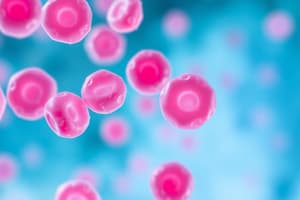Podcast
Questions and Answers
Which of the following conditions represents an absolute increase in the number of circulating eosinophils?
Which of the following conditions represents an absolute increase in the number of circulating eosinophils?
- Lymphocytosis
- Monocytosis
- Leukocytosis
- Eosinophilia (correct)
What is the primary mode of transmission for the Epstein-Barr virus (EBV)?
What is the primary mode of transmission for the Epstein-Barr virus (EBV)?
- Airborne droplets
- Blood transfusion
- Saliva through personal contact (correct)
- Contaminated food
In the context of leukemia, what distinguishes acute leukemia from chronic leukemia?
In the context of leukemia, what distinguishes acute leukemia from chronic leukemia?
- Acute leukemia is caused by viral infections; chronic leukemia is caused by genetic mutations.
- Acute leukemia primarily affects children, while chronic leukemia predominantly affects adults.
- Acute leukemia always presents with lymphadenopathy, while chronic leukemia does not.
- Acute leukemia is characterized by undifferentiated cells and rapid onset and short duration, while chronic leukemia involves more differentiated cells and slower progression. (correct)
Which of the following factors is NOT typically associated with causing leukocytosis?
Which of the following factors is NOT typically associated with causing leukocytosis?
A patient's lab results show a 'shift to the left'. What does this indicate?
A patient's lab results show a 'shift to the left'. What does this indicate?
Which of the following is a typical characteristic of Hodgkin lymphoma?
Which of the following is a typical characteristic of Hodgkin lymphoma?
Which of the following is most closely associated with Burkitt lymphoma?
Which of the following is most closely associated with Burkitt lymphoma?
Which of the following is a common characteristic of lymphoblastic lymphoma?
Which of the following is a common characteristic of lymphoblastic lymphoma?
What is the typical treatment for an overactive spleen?
What is the typical treatment for an overactive spleen?
What is the significance of enlarged lymph nodes in the context of disease?
What is the significance of enlarged lymph nodes in the context of disease?
What is a key characteristic of chronic lymphocytic leukemia (CLL)?
What is a key characteristic of chronic lymphocytic leukemia (CLL)?
Which of the following best describes the progression of non-Hodgkin's lymphoma?
Which of the following best describes the progression of non-Hodgkin's lymphoma?
What is the common trait among cancerous lymphomas?
What is the common trait among cancerous lymphomas?
What is one of the most common symptoms of Hodgkin lymphoma?
What is one of the most common symptoms of Hodgkin lymphoma?
Which disease is related by proliferation of malignant lymphocytes in the lymphoid system?
Which disease is related by proliferation of malignant lymphocytes in the lymphoid system?
Why is early detection important for Hodgkin lymphoma?
Why is early detection important for Hodgkin lymphoma?
Which population is lymphoblastic lymphoma prevalent?
Which population is lymphoblastic lymphoma prevalent?
An increase in the size and number of germinal centers of the lymph node indicate what?
An increase in the size and number of germinal centers of the lymph node indicate what?
EBV is associated with almost all cases of what condition?
EBV is associated with almost all cases of what condition?
A patient presents with fever, weight loss, night sweats and fatigue. They also have large, painless neck nodes. What condition is most likely?
A patient presents with fever, weight loss, night sweats and fatigue. They also have large, painless neck nodes. What condition is most likely?
A patient is determined to have acute leukemia after presenting with undifferentiated or immature cells during testing. What can be said about the patient's expected survival?
A patient is determined to have acute leukemia after presenting with undifferentiated or immature cells during testing. What can be said about the patient's expected survival?
An overactive spleen can lead to what condition?
An overactive spleen can lead to what condition?
What can be said about the etiology of Chronic Lymphocytic Leukemia (CLL)?
What can be said about the etiology of Chronic Lymphocytic Leukemia (CLL)?
What is the most common association for monocytosis?
What is the most common association for monocytosis?
What is the median survival for Multiple Myeloma?
What is the median survival for Multiple Myeloma?
Flashcards
Leukocytosis
Leukocytosis
Higher than normal leukocyte count as a protective response to stressors.
Granulocytosis
Granulocytosis
Increase in granulocytes released from the bone marrow.
Shift to the Left
Shift to the Left
Immature neutrophils are released from the bone marrow due to high demand.
Eosinophilia
Eosinophilia
Signup and view all the flashcards
Monocytosis
Monocytosis
Signup and view all the flashcards
Lymphocytosis
Lymphocytosis
Signup and view all the flashcards
Infectious Mononucleosis
Infectious Mononucleosis
Signup and view all the flashcards
Leukemia
Leukemia
Signup and view all the flashcards
Acute Leukemia
Acute Leukemia
Signup and view all the flashcards
Chronic Leukemia
Chronic Leukemia
Signup and view all the flashcards
Acute Lymphocytic Leukemia (ALL)
Acute Lymphocytic Leukemia (ALL)
Signup and view all the flashcards
Acute Myelogenous Leukemia (AML)
Acute Myelogenous Leukemia (AML)
Signup and view all the flashcards
Chronic Lymphocytic Leukemia (CLL)
Chronic Lymphocytic Leukemia (CLL)
Signup and view all the flashcards
Chronic Myelogenous Leukemia (CML)
Chronic Myelogenous Leukemia (CML)
Signup and view all the flashcards
Lymphadenopathy
Lymphadenopathy
Signup and view all the flashcards
Lymphomas
Lymphomas
Signup and view all the flashcards
Hodgkin Lymphoma
Hodgkin Lymphoma
Signup and view all the flashcards
Hodgkin Lymphoma Symptoms
Hodgkin Lymphoma Symptoms
Signup and view all the flashcards
Non-Hodgkin Lymphoma
Non-Hodgkin Lymphoma
Signup and view all the flashcards
Burkitt Lymphoma
Burkitt Lymphoma
Signup and view all the flashcards
Lymphoblastic Lymphoma
Lymphoblastic Lymphoma
Signup and view all the flashcards
Multiple Myeloma
Multiple Myeloma
Signup and view all the flashcards
Splenomegaly
Splenomegaly
Signup and view all the flashcards
Splenectomy
Splenectomy
Signup and view all the flashcards
Study Notes
- Leukocytes include granulocytes, monocytes, and lymphocytes.
- Leukocyte disorders are categorized as quantitative or qualitative.
- Quantitative disorders involve the number of leukocytes
- Qualitative disorders involve leukocyte function.
Leukocytosis
- Leukocytosis denotes a higher-than-normal leukocyte count.
- It is a normal protective response to stressors.
- Stressors can include infection, exercise, or emotional changes.
- Leukemia is never a normal condition.
- It can be caused by radiation, anaphylactic shock, autoimmune disease, or certain drugs.
Granulocytosis
- Granulocytosis involves an increase in granulocytes released from the bone marrow.
Shift to the Left (Leftward Shift)
- Shift to the left occurs when the demand for mature neutrophils exceeds the supply.
- The bone marrow releases immature neutrophils.
Eosinophilia
- Eosinophilia is an increase in the number of circulating eosinophils.
- It is associated with allergic disorders like asthma and parasitic infections.
Monocytosis
- Monocytosis represents an increase in circulating monocytes.
- It is commonly associated with bacterial infections.
Lymphocytosis
- Lymphocytosis refers to an increase in lymphocytes
- It often occurs in acute viral infections.
Infectious Mononucleosis
- Infectious mononucleosis is a benign, self-limiting syndrome.
- It is caused by acute viral infection of B lymphocytes with EBV, a herpes virus.
- Transmission is usually through saliva, hence the name "kissing disease".
Leukemia
- Leukemia is a disorder of leukocytes in the bone marrow and blood.
- It involves uncontrolled proliferation of malignant leukocytes.
- There is a decreased production and function of normal hematopoietic cells.
- Acute leukemia has undifferentiated or immature cells and rapid onset.
- Chronic leukemia has more differentiated cells but impaired function and slow progression.
- Acute leukemias include Acute Lymphocytic Leukemia (ALL) and Acute Myelogenous Leukemia (AML).
- Chronic leukemias include Chronic Myelogenous Leukemia (CML) and Chronic Lymphocytic Leukemia (CLL).
- CLL is rare in individuals under 45 and more common between 50 and 70 years old.
- Chronic leukemias have a longer life expectancy.
- There is a statistical tendency for leukemia to reappear in families.
- Increased risk in adults is associated with exposure to cigarette smoke, benzene, and ionizing radiation.
Lymphadenopathy
- Lymphadenopathy is caused by an increase in size and number of germinal centers of the lymph nodes.
- Localized lymphadenopathy usually indicates drainage of an area with inflammation or infection.
- Generalized lymphadenopathy usually results from a malignant or non-malignant disease.
Lymphomas
- Lymphomas develop from proliferation of malignant lymphocytes in the lymphoid system.
- Hodgkin lymphoma and non-Hodgkin lymphoma occur in children and adults.
- Treatment and prognosis depend on the stage and type of lymphoma.
- The rate of non-Hodgkin's lymphoma has doubled since the 1970s.
- This increase in the number of cases is possibly due to immune deficiencies, including AIDS and organ transplants
Hodgkin Lymphoma
- Classic Hodgkin lymphoma is derived from a B cell that has not undergone successful immunoglobulin gene rearrangement.
- Survival of the cell may be linked to EBV infection.
- Clinical manifestations include fever, weight loss, night sweats, fatigue, and large, painless neck nodes.
- Early detection is difficult, and early lymphadenopathy can progress undetected for years.
- Survival rate depends on early detection.
Non-Hodgkin Lymphoma
- Non-Hodgkin lymphoma features progressive clonal expansion of B cells, T cells, and/or NK cells.
- Lymphomas originate from mutations in cellular genes, possibly environmentally induced.
- Successful treatment depends on the type and stage of lymphoma, cell type, and other factors.
- Overall survival rate is less than Hodgkin lymphoma.
Burkitt Lymphoma
- Burkitt lymphoma is a highly aggressive B-cell non-Hodgkin lymphoma.
- It accounts for 30% of childhood lymphomas worldwide.
- EBV is associated with almost all cases.
- Tumors in the jaw and facial bones are indicative of lymphoma.
Lymphoblastic Lymphoma
- Lymphoblastic lymphoma is a rare variant of non-Hodgkin lymphoma.
- It accounts for 20% of cases in children and adolescents.
- The T-cell variant is associated with a mediastinum mass.
- It results in chest pain and may cause compression of bronchi or the superior vena cava.
Conditions Mimicking Lymphomas
- Important distinction between lymphomas and other conditions is localized lymphadenopathy.
Multiple Myeloma
- Multiple myeloma is a biologically complex disease with wide range of genetic alterations.
- It has a poor prognosis.
- Median survival is three years.
Spleen Functions
- The spleen's relationship to the immune and hematologic systems was identified in the 18th century.
Splenomegaly
- Splenomegaly without a specific etiology is seen in 7-15% of individuals.
Overactive Spleen
- An overactive spleen results in hematologic alterations, reducing circulating blood cells.
- The spleen can sequester up to 50% of the red blood cell population, potentially leading to anemia.
- Splenectomy is a treatment option but not always the best choice.
- Individuals can lead normal lives after splenectomy, but hematologic abnormalities often exist.
Studying That Suits You
Use AI to generate personalized quizzes and flashcards to suit your learning preferences.



